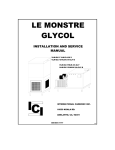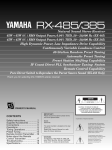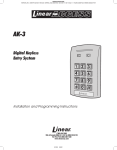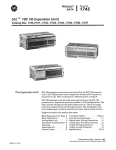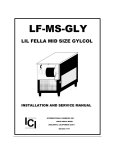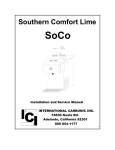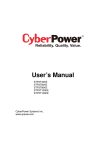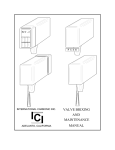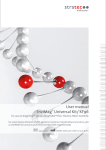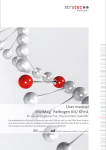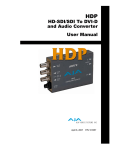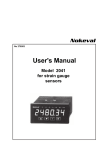Download Flash Chiller - Sentry BevCon
Transcript
"FLASH CHILLER" VLM-FC Installation and Service Manual REMOTE SELF CONTAINED ICI INTERNATIONAL CARBONIC INC. 16630 KOALA DR. ADELANTO, CA. 92301 IMPORTANT: This manual is a guide for installing, operating, servicing and maintaining this equipment. Refer to Table of Contents for page location of detailed information to answer questions that arise during installation, operating, service and maintenance, or installation of this equipment. TABLE OF CONTENTS PAGE PREFACE ............................................................................................1 GENERAL DESCRIPTION System Description...............................................................................2 Design Data..........................................................................................2 Flash Chiller Exploded View .................................................................3 Flash Chiller Exploded View Description ..............................................4 Electrical Schematic .............................................................................5 Theory of Operation..............................................................................6 Installation ............................................................................................6 Unpacking and Inspection ....................................................................6 Selecting Location ................................................................................6 Location Recommendations for Flash Chiller .......................................6 Install Drain Line...................................................................................6 Electrical Requirements........................................................................7 Preparing System for Operation ...........................................................7 Preparing and Starting Refrigeration Unit .............................................7 Checking Water Bath............................................................................7 Periodic Cleaning .................................................................................7 Cleaning Condenser Coil......................................................................7 Checking and Changing Water Bath ....................................................8 Sanitizing Procedures...........................................................................9 Trouble Shooting ..................................................................................10 Notes ....................................................................................................12 PREFACE INTERNATIONAL CARBONIC INC. has enjoyed over 52 years of manufacturing excellence in the field of carbonation and in the beverage related industry. We have had a long and proud history with quality as our standard and innovation as our goal. Originally started just after World War II in Canfield, Ohio as Carbonic Dispensers. We enjoyed patents on the first Sodajet type carbonator. This method of carbonation instantaneously carbonated the water to 100% saturation. We developed the first patented dispensing valve to dispense bulk beverage with carbonation equal to or in excess of bottled beverages. A valve with three flavors and soda was another first. We were the first to incorporate the total postmix package, i.e., carbonation, refrigeration, and the ability to dispense from one self contained unit. We have pioneered many such firsts and will continue to develop advanced systems for the future, such as electronic interrogatable portion controls to electronic liquid level controls. We hope you enjoy this piece of equipment that has been produced to give many years of trouble free service. We thank you for your purchase and hope we may serve you in the future. 1 CHAPTER I GENERAL DESCRIPTION This chapter gives the description, theory of operation, and design data for the FLASH CHILLER and FLASH CHILLER-3/4, and related components. SYSTEM DESCRIPTION The FLASH CHILLER is a complete self-contained remote cooling unit which when combined with related components, will cool and dispense ice-cold beer. The FLASH CHILLER consists of a condensing unit, a water reservoir, beer cooling coils, an agitator pump housed in an all stainless steel cabinet. The FLASH CHILLER is manufactured with all stainless steel construction and is insulated with polyurethane foam. The FLASH CHILLER is manufactured in remote or self-contained configurations. The Flash Chiller is manufactured as a standard 1/2 H.P. condensing unit and can be manufactured in a 3/4 H.P. configuration. Both models can be manufactured in a remote configuration. For proper function the FLASH CHILLER must have an electrical supply and drainage. DESIGN DATA COOLING UNIT Overall cabinet dimensions: Height Width Depth Weights: Shipping Dry weight Operational Weight Ice Bank FLASH CHILLER FLASH CHILLER 3/4 45 5/8” 22” 24 1/2” 47 5/8” 22” 24 1/2” 228 193 379 90 255 220 406 90 Capacities: Unit water bath (no ice bank) Refrigerant requirement (R-134-A) 1/2 H.P. 285 Ambient operating temperature 22.5 gallons 3/4 H.P. 331 grams 40 F to 100 F. Electrical Requirements: The cooling unit requires a 115 VAC 60 Hertz or 220 VAC 50 Hertz single-phase power circuit. Please notify the factory or factory representative if a deviation of this requirement is required. Circuit Ampacity Condensing Unit Agitator FLASH CHILLER 110VAC 220VAC FLASH CHILLER 3/4 110VAC 220VAC 10.2 Amps 8.8 Amps 1.4 Amps 11.5 Amps 10.1 Amps 1.4 Amps 2 5.1 Amps 4.4 Amps .7 Amps 5.8 Amps 5.1 Amps .7 Amps 2 1 3 4 6 5 7 19 3 21 3 9 8 10 3 3 11 13 14 12 20 18 22 16 23 15 17 24 25 29 3 30 28 26 31 27 3 36 32 32 33 35 34 37 FLASH CHILLER INTERNATIONAL CARBONIC INC. 38 ICI 32 39 ADELANTO, CALIFORNIA 3 TITLE FLASH CHILLER DATE 2/23/00 DRN. BY CHK. BY APPR. BY GLW GLW GLW FLASH CHILLER SYM QTY PART NO. DESCRIPTION 1 1 S-416 AGITATOR/COIL POSITIONING BRACKET 2 1 S-417 WASTE DRAIN POSITIONING BRACKET 3 1 A-20 SCREW, 8-32 X 3/8 T.H., S.S. 4 2 F-4 5 1 S-850 6 1 42-1020-80 7 1 S-418 RISER 8 1 S-419 RISER STIFFENER 9 1 S-420 MUG REST SCREW AGITATOR/CIRCULATOR PUMP TWO FAUCET BEER TOWER 10 1 ..... TOWER JAM NUT 11 1 S-421 TOP 12 1 S-422 WASTE DRAIN ASSY. 13 4 S-1323 EVAPORATOR GUIDE WEDGE 14 4 S-499 EVAPORATOR COIL RETAINER 15 4 S-423 EVAPORATOR SUPPORT BRACKET 16 1 S-409 9" ACCUMULATOR 17 1 S-497 EVAPORATOR ASSEMBLY 18 1 ..... 1/8 CAP TUBE, 10.5 19 1 S-513-A ICE BANK CONTR0L 20 1 S-424 ICE BANK BULB BRACKET 21 1 S-425 #1 COIL 102 FEET 5/16 S.S. TUBING 22 1 S-426 #2 COIL 118 FEET 5/16 S.S. TUBING 23 1 S-427 COIL BASKET 24 1 S-428 STANDPIPE 25 1 S-429 BUCKET COMPLETE 26 1 S-430 DRAIN OUTLET, WASTE 27 1 S-489 DRAIN OUTLET, STANDPIPE 28 1 S-432 CABINET SHELL ONLY 29 4 S-46 BUSHING 30 1 S-491 REAR LINE COVER 31 1 S-433 REAR PANEL 32 3 S-434 SIDE, AND FRONT PANELS 33 1 AKA7437YXAXA 1/2 H.P. CONDENSING UNIT AKA4476YXA AJA7465YXAXG AJA7461YXA 1/2 COMPRESSOR ONLY 3/4 H.P. CONDENSING UNIT 3/4 COMPRESSOR ONLY 34 1 SET S-854 LEGS 35 1 P0003 2 X 4 "J" BOX WITH LID 36 1 P0004 2 X 4 "J" LID 37 1 VDS-16P-110 COMPRESSOR PROTECTOR 110 V. VDS-16P-230 COMPRESSOR PROTECTOR 230 V. 38 2 A-46 39 1 E-141-12 5/16 X 18 FLANGE WHIZ LOCK SCREW, 3/4" CORD 4 BLACK BLACK RIBBED WHITE BLACK BLACK BLACK GREEN WHITE GREEN BLUE BROWN GREEN/YELLOW AKA7437YXAXA AJA7465YXAXG ELECTRICAL FIELD WIRING AND INSTRUCTIONS IDENTIFICATION RIB (NEUTRAL) POWER CORD (GROUND TYPE) COMP. TERMINALS MUST BE COPPER CONDUCTORS ONLY. S R OVERLOAD 1 3 C 1. INCOMING POWER LEADS BLACK RED RUN CAPACITOR YELLOW IF USED S M UP RED R 5 REGARDLESS OF LOCATION. L FAN (CONDENSER) RELAY BLACK OR BLUE S 2 6 1 4 CONNECT LEADS TO SAME NUMBERED TERMINALS, 2 3 1 C RELAY 3. WHEN T.P.CO. APPROVED ALTERNATE RELAY IS USED. G 1 POWER LEADS FROM DISCONNECT SWITCH OVERLOAD 4. A JUMBER WIRE MAY BE CONNECTED BETWEEN #4 & #6 TERMINALS TO DISTRIBUTE WIRES FOR EASE OF WIRING. THE #4 AND #6 TERMINALS ARE YELLOW COMPRESSOR TERMINALS GROUNDING SCREW CONTROL BOX START CAPACITOR 2. CONNECT INCOMING GROUND LEAD TO GREEN GROUND SCREW. LOW PRESSURE CONTROL START CAPACITOR FAN (CONDENSER) W/ BLEEDER RESISTOR WIRINGTERMINALS WITH NO INTERNAL CONNECTION TO RELAY. INTERNATIONAL CARBONIC INC. ICI ADELANTO, CALIFORNIA 5 TITLE FLASH CHILLER WIRING DIAGRAM DATE 11/1/05 DRN. BY CHK. BY APPR. BY GLW THEORY OF OPERATION The FLASH CHILLER was designed to cool and dispense ice-cold beer. The water bath holds approximately 22.5 gallons of water. A certain amount of this water will be transformed into ice, approximately 100 pounds. This water reserve and ice bank will act as a reservoir for refrigeration. This reserve is utilized during peak periods when the BTU output of the compressor is not sufficient to meet the demand of the draw. INSTALLATION This chapter covers unpacking and inspection, selecting location, installing FLASH CHILLER and related components, connecting water inlet and electrical requirements. UNPACKING AND INSPECTION Upon receiving unit, immediately remove unit from shipping carton and inspect for shipping damage. NOTE: Before leaving the factory all FLASH CHILLER units were carefully inspected and the carrier has accepted and signed for them. Any damage or irregularities should be noted at the time of delivery and immediately reported to delivering carrier. Request a written inspection report from claims inspector to substantiate any necessary claim. File claim with delivering agency, not International Carbonic Inc.! SELECTING LOCATION IMPORTANT: Ambient temperature for FLASH CHILLER should not exceed 100 degrees “F”. Operation of FLASH CHILLER in ambient above 100 degrees “F” can and will contribute to early failure of condensing unit and poor quality of finished product. LOCATION RECOMMENDATIONS FOR FLASH CHILLER 1. Position unit as close as possible to proper electrical source. 2. Position unit with a minimum of 2” space between bulkhead and cabinet for sufficient ventilation. Allow enough space between ceiling and unit for lid removal. 3. Position unit as close as possible to proper drainage. 4. Place FLASH CHILLER in position. Make sure sufficient space between bulkheads, walls and overheads is available for proper air circulation around cooling unit. INSTALL DRAIN LINE 1. Connect drain lines on FLASH CHILLER unit with drain using 3/4” I.D. clear plastic pipe or 3/4” PVC to nearest outlet. 2. Do not reduce drain connection from cabinet outlet. 3. Be sure all connections are watertight. 6 ELECTRICAL REQUIREMENTS: The FLASH CHILLER requires a 120 VAC, single phase at 60 Hertz or 230 VAC, single phase at 50-hertz power circuit, and must be wired in accordance with N.E.C. or local ordinance. NOTE: Check CHAPTER I for running amperage and connect to appropriate electrical circuit. PREPARATION All previous steps should be understood and carried out before proceeding. PREPARING SYSTEM FOR OPERATION PREPARING AND STARTING REFRIGERATION UNIT 1. FLASH CHILLER refrigeration is pre-set at factory and ready to operate. 2. Remove lid. 3. Fill water bath with clean water until water runs out of drain standpipe, (S-428). 4. Plug FLASH CHILLER power cord into electrical receptacle box. Two things will happen immediately. One, the agitator will come on and the compressor protector yellow light will come on. The yellow compressor protector light will come on only if proper voltage is supplied to the FLASH CHILLER. In approximately 3 minutes the green light will illuminate and the yellow light will de-energize. At this time make sure compressor and condenser fan motor. The process of cooling the water bath will now commence. With ambient and water temperature of 75 degree “F” initial pull down or formation of complete ice bank will take approximately 7 hrs. When full ice bank has been formed, compressor and condenser fan motor will stop. Agitator will continue to operate, circulating water in water bath. CHECKING WATER BATH Periodically check water level in water bath. If it is low more water should be added as instructed for maximum product cooling. This dehydration will normally not occur in normal temperate climate zones. With normal humidity the opposite will occur therefore a condensate drain is installed. Any extra water in the water bath will exit the unit via the drain outlet. When unit is building it's first ice bank it is normal to have water overflow the into the overflow standpipe and out drain hose. PERIODIC CLEANING Periodically wash all external surfaces of FLASH CHILLER cabinet, rinse with clean water, and then wipe dry with a clean soft cloth. DO NOT USE ABRASIVE TYPE CLEANERS. CLEANING CONDENSER COIL IMPORTANT: Air circulation through the condenser coil is required to cool the compressor. Air is drawn in through grills on the front of the FLASH CHILLER, through condenser coil and exhausted out vents and sides of FLASH CHILLER. Restricting air circulation through the FLASH CHILLER will decrease its cooling capacity. 7 NOTE: Cleaning condenser coil should be done during non-use periods. 1. Unplug refrigeration unit power cord from electrical socket. 2. Remove service panels. 3. Vacuum or use a soft brush to clean fins of condenser coil. Use low-pressure compressed air or C02 gas to blow through condenser fins. This should only be performed after normal business hours to prevent dust contamination. A damp cloth on backside of condenser coil will prevent some dust contamination 4. Replace service panels. S. Plug FLASH CHILLER power cord in electrical socket. CHECKING / CHANGING WATER BATH Periodically check water level in water bath. If it is low, more water should be added for maximum product cooling. Before adding more water, water bath and ice bank should be checked for excessive mineral deposit build up. NOTE: The water in water bath should be changed and all components in water bath should be cleaned as often as necessary to keep it clean. A convenient time to perform this operation is when the system is being sanitized. 1. Unplug refrigeration unit power cord from electrical socket. 2. Remove lid from unit. 3. Look down into water bath (if necessary, use flashlight) and inspect water bath, ice bank and all components for cleanliness. Water, ice bank and all components should be clear and free of foreign particles. If ice bank is clear of foreign particles, it does not have to be melted down. Proceed to step 10 if foreign particles are present in the ice bank, proceed to step 4. 4. Siphon out water with short hose or pull out over flow standpipe. 5. Allow ice bank to melt. Hot water may be used to speed melting. CAUTION: Never use an ice pick or other sharp instruments to remove ice from evaporator coil. Such practice can result in puncture to the refrigeration circuit. 6. Use fiber brush and carefully clean mineral deposit from all components. 7. Wash evaporator coil with a mild soap solution. Copper cleans well with mild solution of citric acid (1 cup of citric acid for 2 gallons of water). Stainless steel cleans well with carbonated water. Then rinse with clean water. 6. Rinse out water bath with clean water until water running out of siphon hose is clean. 9. Insert standpipe in drain hole 10. Fill water bath to top of standpipe. 11. Replace lid. 12. Plug refrigeration unit power cord in electrical socket. 8 SANITIZING PROCEDURES Your local health department rules and general area cleanliness should determine the frequency at which the unit should be sanitized. EQUIPMENT REQUIRED: 1. 2. 3. 4. 5. Stainless Steel containers (product tanks), or large volume container. CO2 Supply if applicable (Same as used with dispensing unit). Cleaning Agent. Sanitizing Solution. Phenolphthalein. NOTE: One recommended cleaning agent and sanitizing agent is manufactured by: MT. HOOD CHEMICAL CORP. 4444 N.W. Yeon Avenue Portland, Oregon 97210 Trade names are: STAR - CHLORINATED CLEANER CROWN - 12.5% SODIUM HYPOCHLORITE BLEACH Use STAR at 18 oz. per 1 gallon of water yields 2% Sodium Hydroxide Solution. Use Crown at 2 ounce per 9 gallons of water (gives 200 PPM of available chlorine) at a minimum contact time of 10 minutes. 1. Disconnect syrup containers and remove product from tubing by purging with carbon dioxide or flushing with warm water. 2. Visually inspect valve by removing nozzle and inspecting nozzle and valve cavity. Clean nozzle with cleaning agent, then sanitizing solution, then with potable water. Inspect valve cavity and if dirty clean with soft bristle brush. Clean exteriors of valve with a soft clothe and warm water. Replace valve nozzle then go to step #3. 3. Fill syrup lines with a caustic-based (low sudsing, non-perfumed, and rinsed) detergent solution, (STAR). The solution should be prepared in accordance with the manufacturers recommendations, but should be at least 2 percent sodium hydroxide. Make sure the syrup lines are completely filled and allow standing for at least 10 minutes. 4. Flush the detergent solution from the syrup lines with clean water. Continue rinsing until testing with phenolphthalein shows that the rinse water is free of residual detergent. 5. Fill the syrup lines with a low PH (7.0) chloride solution containing maximum 200-PPM chlorine. Make sure that lines are completely filled and allow standing for 30 minutes. 6. Reconnect syrup containers and ready Unit for operation. 7. Draw drinks to refill syrup lines and flush the chloride solution from the dispenser. 8. Taste the beverage to verify that there is no off taste. 9 TROUBLE SHOOTING IMPORTANT: Only qualified personnel should service the FLASH CHILLER unit and components. WARNING: To avoid personal injury and or property damage, always disconnect electrical power. Disconnect all beer lines. If repairs are to be made to system, bleed pressure before proceeding. FLASH CHILLER Trouble Frozen water bath Cooling or condensing unit nonoperational Agitator motor not operating Probable Cause 1. 2. 1. 2. 3. 4. Bad ice bank control. Refrigerant leak causing undercharge. Defective agitator motor. Dirty water bath. 1. No electrical power. 1. 2. 3. Defective ice bank control. Dirty condenser unit. 2. 3. 4. Improper voltage/amperage 4. 5. Loss of refrigerant. 5. 6. 7. 8. Bad overload and relay. Compressor bad. Restriction (pinched or crimped line). Agitator propeller obstructed or lost. Low voltage. 6. 7. 8. Loose, unplugged, or broken wiring. Bad agitator motor. No power source. 3. Electrical power to cooling unit turned off. Low voltage. 2. Loose, disconnected, or broken wire. Inoperative ice bank control. 4. 5. Voltage must be at least 110 V at compressor terminals at start. Tighten connection or replace broken wiring. Replace ice bank control. Inoperative overload protector or start relay. Inoperative compressor. Full ice bank. 6. Replace defective part. 7. 8. Replace compressor. Refrigeration not called for. 1. 2. 3. Compressor does not operate Remedy 4. 1. 2. 3. 4. 5. 6. 7. 8. 3. 4. 10 1. 2. 4. 1. 3. Replace bad ice bank control. Repair leak, evacuate and recharge. Replace defective agitator. Melt ice, empty & clean bath. Replenish w/fresh water. Plug power cord into electrical box. Check on/off switch. Check Compressor Protector, replace if necessary. Replace ice bank control. Clean condenser unit w/vacuum cleaner. Check for proper voltage/amperage. Repair leak and replenish refrigerant. Replace overload and relay Replace compressor. Repair, straighten or replace defective line. Remove obstruction or reAttach propeller. Voltage must be at least 110/220 volt at terminals. Tighten connection or replace broken wiring. Replace agitator motor. Plug power cord to electrical box. Check line voltage. Turn on power switch to unit. Compressor works continuously but does not form sufficient ice bank 1. Cooling capacity is exceeded by over drawing. Reduce amount of drinks taken per given time of install higher volume unit. 2. Cooling unit located in 2. Relocate cooling unit. Or cool excessively hot area. area. 3. Air circulation through condenser 3. Check and if necessary, clean coil is restricted condenser coil. 4. Loss of refrigerant or in-sufficient 4. Repair leak and/or recharge with charge. sufficient refrigerant. Note: Ice bank freezes from bottom of evaporator upward. A refrigerant leak or insufficient charge might show ice at bottom and not at top of evaporator. Compressor will 1. Ice bank control capillary tube 1. Replace ice bank control. not stop after kinked or broken. 2. Ice bank control stuck in closed 2. Replace ice bank control. sufficient ice position. bank is produced Note: During overload protector shut off condenser fan motor will continue to work. Otherwise, troubleshooting condenser fan motor problems is the same as “Compressor does not operate”, paragraph in addition to the following. Condenser fan 1. Electrical cord loose or 1. Tighten connections or replace motor not disconnected from condenser fan cord. operating motor or compressor terminals. 2. Fan blade obstructed. 2. Remove obstruction. 3. Inoperative condenser fan motor. 3. Replace condenser fan motor. 11 1. NOTE SECTION Frequently Called Numbers: __________________________________ ____________________________ __________________________________ ____________________________ __________________________________ ____________________________ __________________________________ ____________________________ __________________________________ ____________________________ __________________________________ ____________________________ CO2 SETTINGS: High Pressure ________________________ PSI Low Pressure ________________________ PSI _____________________________________ __________________________________ _____________________________________________________________________________________________ _____________________________________________________________________________________________ _____________________________________________________________________________________________ _____________________________________________________________________________________________ _____________________________________________________________________________________________ ___________________________________________________ _____________________________________________________________________________________________ _____________________________________________________________________________________________ _____________________________________________________________________________________________ _____________________________________________________________________________________________ _____________________________________________________________________________________________ ___________________________________________________ _____________________________________________________________________________________________ _____________________________________________________________________________________________ _____________________________________________________________________________________________ _____________________________________________________________________________________________ _____________________________________________________________________________________________ ___________________________________________________ 12















